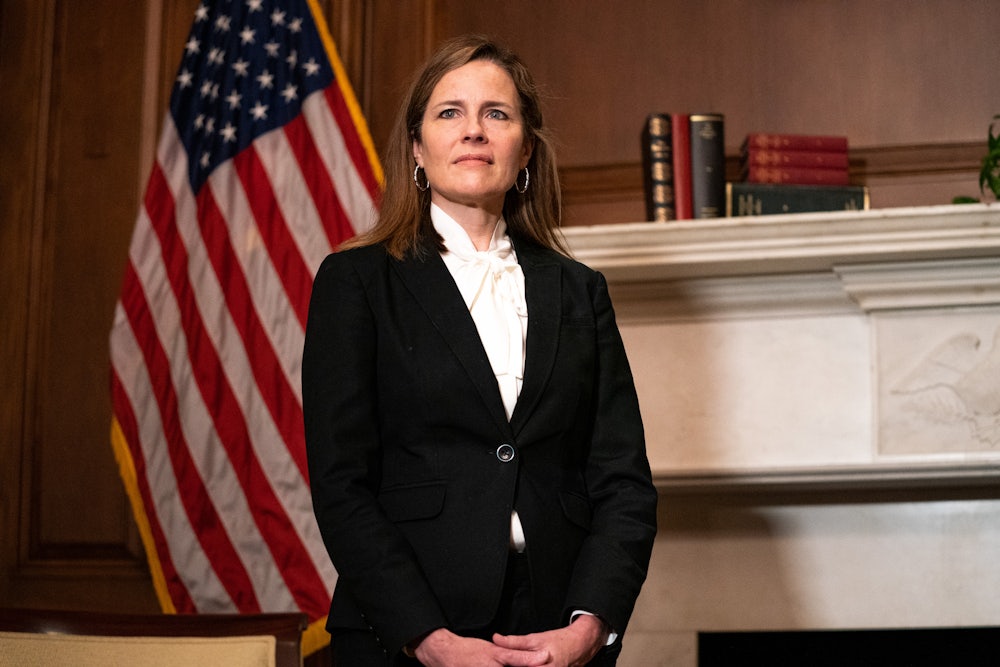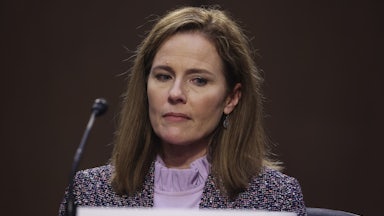If you were a parodist for The Onion, “Justice Amy Coney Barrett Insists Supreme Court Isn’t Partisan at McConnell Center Event” probably wouldn’t even get you a courtesy chuckle from your co-workers at a pitch meeting. Reality, however, clearly has a more surreal sense of humor than any mortal can muster, because this incredible moment of irony is exactly what occurred this weekend in Louisville, Kentucky.
“My goal today is to convince you that this court is not comprised of a bunch of partisan hacks,” the court’s newest justice reportedly told an audience at an event celebrating the thirtieth anniversary of the University of Louisville’s McConnell Center. The center is named for Senate Minority Leader Mitch McConnell, who was present as Barrett spoke, and who has, for these past many years, served as the loyal bagman for the larger conservative judicial project. “To say the court’s reasoning is flawed is different from saying the court is acting in a partisan manner,” Barrett reportedly said. “I think we need to evaluate what the court is doing on its own terms.”
That same day, Justice Stephen Breyer also tried to defend the court’s public image from charges of partisanship. “I’m there for everybody,” Breyer told Fox News’s Chris Wallace in an interview about his new book, which also decries efforts to “politicize” the Supreme Court. “I’m not just there for the Democrats. I’m not just there for the Republicans. And I’m not just there because a president was a Democrat who appointed me.”
One thing is clear: The mission to cast the Supreme Court as apolitical and nonpartisan remains bipartisan. It is also a folie à deux of sorts: a madness shared by at least two on either side of the high court’s ideological divide. Rather than take their word for it, we might ask these esteemed jurists: “Sorry, but who exactly do you think you’re kidding?”
What, pray tell, do Breyer and Barrett mean by “political”? If that merely means “involved in politics,” then yes, the Supreme Court is obviously and inescapably political. It plays a significant role in shaping policy at every level of American governance to some degree. The high court’s rulings can substantially alter American life: Look no further than the court’s decision earlier this month to block the Biden administration from enforcing a nationwide eviction moratorium; or its rulings on abortion rights and marriage equality over the past few years; or its rulings on civil rights in the 1950s and 1960s, more distantly.
If you define “political” as “aligned with one of the two major parties,” however, then perhaps the more accurate term is partisan. I have some sympathy when justices insist that their work is misrepresented to the public. Liberal and conservative justices alike have noted that the court actually resolves most of its cases on unanimous or nearly unanimous grounds, and that while there are a number of 5–4 decisions each term, they don’t make up the bulk of the court’s docket. I wrote about this in greater detail after the court’s most recent term.
And yet as I noted then, this understanding of the court’s work flatly misunderstands the public’s interest in the court’s work. The average American does not care how the justices handle obscure civil-procedure questions, how they interpret ERISA, or the standards they use to review patent cases—all matters that the court tends to with enough regularity to deem them an essential part of its workload. But the justices also deliver rulings on areas of interest to a great many Americans, from social issues like abortion and LGBT rights to policy questions such as the scope of the federal government’s power and the constitutionality of major laws. And Americans can’t help but notice that rulings in those cases tend to fall along familiar lines.
I also take Barrett and the other justices at their word when they say they don’t self-identify as partisan actors. Chief Justice John Roberts issued a rare official statement a few years ago to rebuke then-President Donald Trump’s denunciations of lower-court judges as partisan actors. “We do not have Obama judges or Trump judges, Bush judges or Clinton judges,” he said at the time. “What we have is an extraordinary group of dedicated judges doing their level best to do equal right to those appearing before them.” I can also understand why they can be frustrated by the labels of “conservative justices” or “liberal justices,” which are typically used by reporters out of convenience more than analytical rigor. (Barrett and Breyer alike probably prefer them to “Republican-appointed” or “Democratic-appointed.”)
There are some data points to dispute the notion that the Republican-appointed justices always act in Republicans’ political interests. During the Trump years, for example, the Supreme Court refused to give Trump a broad legal shield against subpoenas from the Manhattan district attorney’s office and decisively refused to intervene on his behalf in the 2020 presidential election after Biden’s victory became clear, and it has generally resisted efforts to rule against Covid-19 restrictions enacted on public health grounds. Barrett herself notably squelched a legal campaign to block a college vaccine mandate last month, defying what is rapidly becoming GOP orthodoxy.
But there are far more instances where it delivers rulings favored by the parties that nominated them. The justices would like you to believe this is a weird coincidence. “Judicial philosophies are not the same as political parties,” Barrett said on Sunday. At the same time, I’m not so naïve as to believe that parties don’t screen would-be justices for certain ideological views. No modern president is foolish enough to ask a judicial nominee how they would rule in a specific case. (Well, except maybe Trump, but each of his three Supreme Court nominees denied under oath that he did.) But they clearly filter them through other means.
Perhaps the best example of this isn’t a sitting Supreme Court justice but the only nominee in the last 30 years who failed to become one. Two vacancies on the high court arose in 2005: one when Sandra Day O’Connor retired in July 2005 and another when then–Chief Justice William Rehnquist died, the following September. George W. Bush had initially nominated Roberts to succeed O’Connor, then renominated him to replace Rehnquist as chief justice after his death. To replace O’Connor, Bush turned to a familiar face: White House Counsel Harriet Miers, whom he formally nominated on October 3 that same year.
“Wait a minute,” you might be asking right now, “there is no Justice Miers on the court.” And you’d be correct. The Senate Judiciary Committee never held a confirmation hearing for Miers, and the Senate never voted on her nomination. She withdrew herself from consideration 24 days after Bush put her name forth. When announcing her decision to withdraw, she cited her expectation that the Judiciary Committee would try to subpoena her records from her time as White House counsel and thereby violate the separation of powers—an obvious face-saving move.
The more apparent reason why she withdrew, however, was the intense right-wing backlash against her nomination. Many conservatives echoed liberals’ reaction to the choice by deriding Miers’s nomination as pure cronyism. She was seen as a stalwart Bush loyalist who had worked with or for him since his early days in Texas politics; her record of legal accomplishments was not particularly exemplary. But those complaints also came with a deeper, more revealing critique from the right: She wasn’t part of the conservative legal movement and couldn’t be trusted to advance its principles.
Many of the Bush administration’s top defenders cried foul. The Weekly Standard’s Bill Kristol wrote that he was “disappointed, depressed, and demoralized” about the choice, soon after it was made public. Of particular concern was Miers’s lack of prior writings about major constitutional issues; she had never served as a judge and had mostly worked as a corporate lawyer in private practice. “To nominate someone whose adult life reveals no record of even participation in debates about constitutional interpretation is an insult to the institution and to that vision of the institution,” Charles Krauthammer wrote in a Washington Post column demanding her withdrawal.
Robert Bork, the conservative legal scholar whose own Supreme Court nomination had been rejected by the Senate in 1987, stated the right’s problem with Miers’s nomination in the clearest terms. “It’s kind of a slap in the face to the conservatives who’ve been building up a conservative legal movement for the last 20 years,” he said in an MSNBC interview before she withdrew. “There’s all kinds of people, now, on the federal bench and some in the law schools who have worked out consistent philosophies of sticking with the original principles of the Constitution. And all of those people have been overlooked.” Miers had to go because she wasn’t part of the club.
The Miers saga is useful for understanding how conservatives have navigated between the Scylla and Charybdis of judicial politics over the past few decades. They can’t nominate Supreme Court justices whose views are too well known, à la Bork, lest they share his fate. Nor can they throw their support behind nominees whose views on constitutional law are too mysterious, lest they nominate another David Souter, the George H.W. Bush pick who quickly became a reliable liberal justice after his confirmation. One of their solutions to this quandary was social networking: Groups like the Federalist Society function less like the top-down clearinghouse that most liberals imagine it to be and more like a Facebook or LinkedIn for like-minded lawyers.
Surely it’s no surprise to anyone that Republicans keep nominating judges and justices who embrace originalism when reading the Constitution and textualism when reading statutes. Those judicial philosophies are most likely to deliver the results that conservatives favor: a narrow reading of federal statutes and congressional powers, a deep skepticism of the Warren court and its landmark decisions, and a philosophical aversion to novelty in basic governance and constitutional rights. Originalists and textualists insist that their philosophies aren’t results-oriented, a point somewhat undermined by the intense backlash that adherents receive when they deliver nonconservative rulings.
In his Fox News appearance this weekend, Breyer pushed back against the partisanship claims by citing a recent decision that defied those expectations. He cited Justice Neil Gorsuch’s vote in Bostock v. Clayton County, where Gorsuch wrote for a 6–3 majority to hold that Title VII of the Civil Rights Act of 1964 protected gay and transgender workers from discrimination. Gorsuch’s textualist ruling was denounced by some of his conservative colleagues on the court as textualism flying under a pirate flag. And beyond the high court, many conservative legal activists responded with outrage at Gorsuch’s perceived betrayal. While Breyer’s example shows how the court as a whole can defy expectations, the response to it shows that those expectations exist for a reason.
If anything, the greatest long-term threat to the Supreme Court’s reputation and public image is the confirmation process itself, which currently serves as kabuki theater for the would-be justices and a bare-knuckled partisan brawl for everyone else. Its original purpose—to ensure qualified nominees reach the Supreme Court—is being subsumed by the nation’s political infrastructures and turned into a membership-to-bench pipeline for ideologues. I’ve previously argued that we should fix this problem by tying each seat to a federal circuit court of appeals, randomizing the process for selecting future justices from those lower courts, and setting 18-year terms for the justices to ensure regular turnover.
I didn’t exactly expect Barrett and Breyer to endorse my plan outright, of course. But I was struck by their coyness in discussing the confirmation process at all. Barrett told audience members in Louisville that the confirmation process itself concerned her but did not discuss its flaws at length or offer ways to fix it. And when Wallace asked Breyer for his take on the process, he demurred and replied that it was “like asking for the recipe for chicken à la king from the point of view of the chicken.” But that snarky distaste did not lead to any recommendations to improve it. “That’s the political environment,” he explained. “Now you may disapprove of it, I may disapprove of it, and if enough people in the public want it to change or be modified one way or the other, it will be.”
The problem, of course, is that the people in power don’t want it to be changed. Democrats and Republicans alike benefit too much from the arms race surrounding judicial nominations to reach a détente of any kind. And the people with the most firsthand experience with the process—and the keenest understanding of its flaws—are declining to comment on it at all. If the justices can’t offer solutions or suggestions to address this problem, then they can’t blame the public for seeing them as part of it—especially when some of them are giving speeches next to senators who made it their life’s work to make it worse.








